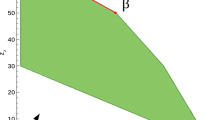Abstract
We describe an extension of Karmarkar's algorithm for linear programming that handles problems with unknown optimal value and generates primal and dual solutions with objective values converging to the common optimal primal and dual value. We also describe an implementation for the dense case and show how extreme point solutions can be obtained naturally, with little extra computation.
Similar content being viewed by others
References
K. M. Anstreicher, Analysis of Karmarkar's algorithm for fractional linear programming, Manuscript, School of Organization and Management, Yale University, New Haven, CT, 1985.
A. Charnes and W. W. Cooper, Programming with linear fraction functionals,Naval Res. Logist. Quart.,9 (1962), 181–186.
A. Charnes, T. Song, and M. Wolfe, An explicit solution sequence and convergence of Karmarkar's algorithm, Manuscript, University of Texas at Austin, Austin, TX, 1984.
V. Chvatal,Linear Programming, Freeman: New York and San Francisco, 1983.
K. R. Frisch, The logarithmic potential method of convex programming, unpublished, University Institute of Economics, Oslo, 1955.
D. Gay, A variant of Karmarkar's linear programming algorithm for problems in standard form, Manuscript, AT&T Bell Laboratories, Murray Hill, NJ, 1985.
A. George and M. T. Heath, Solution of sparse linear least squares problems using Givens rotations,Linear Algebra Appl.,34 (1980), 69–83.
P. E. Gill, W. Murray, M. E. Saunders, J. A. Tomlin, and M. H. Wright, On projected Newton barrier methods for linear programming and an equivalence to Karmarkar's projective method, Manuscript, Department of Operations Research, Stanford University, Stanford, CA, 1985.
G. H. Golub and C. F. Van Loan,Matrix Computations, The Johns Hopkins Press, Baltimore, 1983.
C. Gonzaga, A conical projection algorithm for linear programming, Manuscript, Department of Electrical Engineering and Computer Science, University of California, Berkeley, CA, 1985.
M. Haimovich, The simplex method is very good! On the expected number of pivot stops and related properties of random linear programs, Manuscript, Graduate School of Business, Columbia University, New York, 1983.
M. Heath, Some extensions of an algorithm for sparse linear least squares problems,SIAM J. Sci. Statist. Comput.,3 (1982), 223–237.
P. Huard, Resolution of mathematical programming with nonlinear constraints by the method of centers, inNonlinear Programming (J. Abadie, ed.), North-Holland, Amsterdam, 1967, pp. 207–219.
D. Jensen and A. Steger, Private communication, Department of Applied Mathematics and Statistics, State University of New York at Stonybrook, Stonybrook, New York, 1985.
M. Kallio and E. L. Porteus, A class of methods for linear programming,Math. Programming,14 (1978), 161–16.
N. Karmarkar; A new polynomial time algorithm for linear programming,Combinatorica,4 (1984), 373–395.
N. Megiddo, A variation on Karmarkar's Algorithm, Manuscript, IBM Research Laboratory, San Jose, CA, 1985.
M. J. Todd, Extensions of Lemke's algorithm for the linear complementarity problem,J. Optim. Theory Appl.,20 (1976), 397–416.
J. A. Tomlin, An experimental approach to Karmarkar's projective method for linear programming, Manuscript, Ketron Inc., Mountain View, CA, 1985.
Author information
Authors and Affiliations
Additional information
Communicated by Nimrod Megiddo.
Research supported in part by a fellowship from the Alfred P. Sloan Foundation and by NSF Grant ECS-15361.
Rights and permissions
About this article
Cite this article
Todd, M.J., Burrell, B.P. An extension of Karmarkar's algorithm for linear programming using dual variables. Algorithmica 1, 409–424 (1986). https://doi.org/10.1007/BF01840455
Received:
Revised:
Issue Date:
DOI: https://doi.org/10.1007/BF01840455




